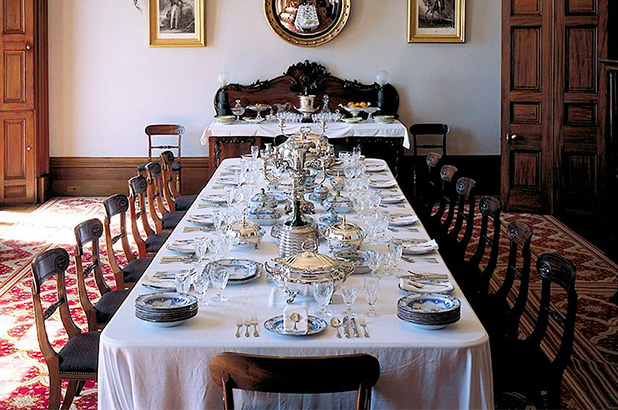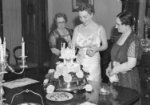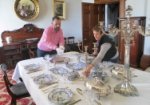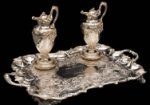As any Downton Abbey or Austen aficionado will tell you there are two obligatory scenes in a costume drama: the ball, and the dinner – and we do love a dinner that pulls out all the stops!
The tables of the affluent and fashion conscious colonists were set just as their counterparts in England (a term they used to mean all of Britain), not only in their choice of dinnerware, but in the arrangement and serving of food. A great source of information as to how tables were set and meals served in the 19th century are servants’ guides. These how-to manuals were published from 1800 onwards but by the 1840s and 50s they really provided a flood of advice to both servants and served alike. Mrs Beeton’s eponymous guides fall within this field. We particularly like James Williams’ The Footman’s Guide, published in 1845, and use it as a reference for recreated table settings at Elizabeth Bay House, along with Vaucluse House and Elizabeth Farm. Williams set out to provide:
… plain instructions to the footman and butler, for the proper arrangement and regular performance of their various duties. In either large or small families. Including the manner of setting-out tables, sideboards, &c in the most fashionable style ; the art of waiting at table, and superintending large and small breakfast, dinner, and supper parties ; directions for cleaning and preserving plate, glass furniture, clothes, &c and for delivering and receiving cards and messages. Interspersed with valuable receipts [i.e. recipes and cleaning formulas], and other information.
![Diagram for the layout of the first course, from James Williams, The footman's guide, Dean and Munday, London, [ca.1845] Diagram for the layout of the first course for fourteen people.](../../app/uploads/sites/2/2013/05/433x690xDinner-party-of-fourteen.jpg.pagespeed.ic.95AoYdB36P.jpg)
Diagram for the layout of the first course, from James Williams, The footman’s guide, Dean and Munday, London, [ca.1845]
An earlier Regency example is Thomas Cosnett’s 1823 The Footman’s directory and butlers remembrancer; or, the advice of Onesimus to his friends. This provides exhaustive information as to the duties of a footman or butler, how to clean lamps (a really filthy job), sharpen knives, polish silver (with a mix of powdered harts-horn and mercury – applied with bare hands!) and set tables, along with this gem of practical 1820s advice:
While waiting at dinner never be picking your nose, or scratching your head or any other part of your body, neither blow your nose in the room; if you have a cold and cannot help doing it, do it on the outside of the door; but do not sound your nose like a trumpet, that all the house may hear when you blow it; still it is better to blow your nose when it requires, than to be picking it and snuffling up the mucus, &c. which is a filthy trick. Do not yawn or gape, or even sneeze, if you can avoid it; and as to hawking and spitting, the name of such a thing is enough to forbid it without a command.
Indeed. The style of the book is also very different to Williams, as Cosnett often uses a ‘conversational’ style, as though he were recording an actual dialogue between ‘Onesimus’, and ‘James’ and ‘William’ who seek his advice:
[Onesimus] And now, William, tell me how you managed the large party you went to the other day to help to wait.
William: Sir, I can assure you that I never got into such a bustle and confusion in all my life before. Sometimes I was sorely vexed, at others I could not help laughing; and I think, had you been there, Sir, you would have laughed to see the awkwardness of the persons, and the disasters which befel us.
Onesimus: I think, William, at such times laughing is not at all allowable; indeed it is always very improper for a servant to be laughing before company. But proceed, William…
Dinner is served
For much of the 19th century both wealthy and humble tables were set ‘a la Francaise’ – literally ‘in the French manner’ – with the individual dishes of a course symmetrically arranged on the table. Diners then served themselves and their neighbours from dishes placed to ‘answer’ each other: savoury corresponding to savoury, sweet to sweet, a vegetable dish to a vegetable dish, a ragout to a fricassee and so on. When diners entered the room, the first course was already laid out, ideally with soup at one end, and fish at the other. In this setting, created to evoke Alexander Macleay’s 80th birthday held at Lake Innes in 1843, you can see the soup tureen ready at one end, with bowls which were then distributed to the diners. The arrangement is straight out of The Footman’s Guide:
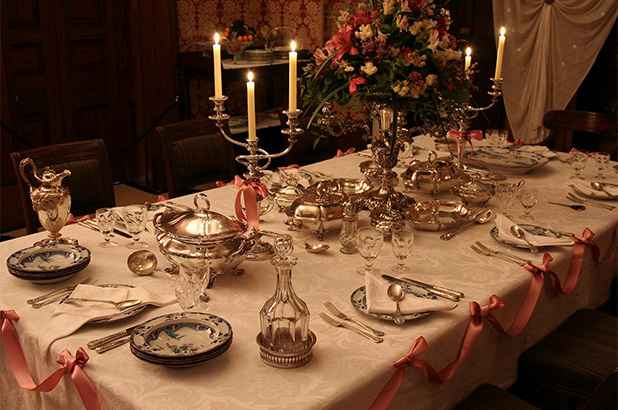
Recreated festive table setting for Alexander Macleay’s 80th birthday celebration. Photo © Leo Rocker
Both the soup and the fish are termed ‘removes’, in that after they were finished they were removed and replaced with another dish, such as a roast which was then carved at the head of the table. For the second course the dishes were replaced, and for a large dinner you would also see additional ‘removes’. The mix of dishes in a second course may seem a tad confusing at first glance. Along with savoury dishes you would also expect to see sweet: roast duck alongside meringues in cream, a beef ragout by the strawberry tarts for instance. This isn’t all that odd if you remember that the rigid demarcation between savoury dishes and sweet courses many of us are used to hadn’t yet become fixed. A parallel is the mixing of tastes in a traditional Cantonese meal, where a sweet dish sits beside a spicy, or the flavors are combined within a single dish (I dread to say ‘sweet and sour pork’ but it’s the obvious example).
Concluding a formal meal, which was ideally for 14 diners – I was once advised that for a successful dinner you should ‘never have as few guests as the Graces (3), nor as many as the Muses (9)’ – posed a distinct challenge to staff, as even the cloth was removed to reveal a polished table, and the dessert course arranged upon doilies. You may remember the Macarthur table setting we discussed earlier, and we’ll be revisiting dessert shortly. By the 1890s a conceptually new dining style was taking hold on fashionable tables: ‘a la Russe’ – ‘in the Russian manner’ – whereby individual plates arrived pre-laden with a selection from various dishes. But that’s a whole other story.
